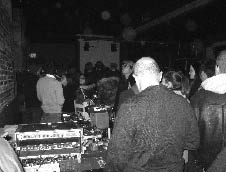Pecha Kucha, Vol. 2
by Albert Chao

At a packed Soundlab, last Friday night, artist Don Paul Swain exclaimed: “Is this madness? Perhaps, but bear with me.” He proceeded to divulge his interest in life and death. An image of Frankenstein was followed by another of Swain, in a laboratory, attempting to imbue clay with life. Lobsterman was another of his fantastic, absurd and amusing creations.
Swain was one of 11 presenters at Buffalo’s Pecha Kucha, Volume 2. There was a great showing of an eclectic array of interests as well as artists. In Pecha Kucha, how you present is as important as what you present. And last Friday, the presenters took advantage of the Pecha Kucha platform: 20 slides, 20 seconds, all-in-all six minutes and 40 seconds each.
To contrast Don Paul Swain’s raw presentation, Bill Helm, photographer and architect, retraced the history of Buffalo’s grain elevators, specifically the recently demolished H-O Oats grain elevator. Helm presented black-and-white slides that dealt with the life and death of the behemoth concrete structures. These grain elevators were an inspiration to modern architecture, influencing architect Le Corbusier and architectural critic Reyner Banham. Helm also presented slides of the demolition of the H-O Oats grain elevator to make way for the controversial Seneca Casino. Near the end, Helm stopped speaking altogether. The audience, gazing at the screen, gave the H-O Oats grain elevators a moment of silence.
While Helm’s revisited the concrete past of Buffalo, Mark Shepard, architect and media artist, was planting gardens—digital gardens in particular. In Tactical Sound Gardens, he begins to weave sound from the digital world into reality. In these gardens, individuals can download sounds wirelessly and begin to manipulate and respond to them. These sound gardens can take place anywhere, and Shepard plans to expand his idea into different cities.

Moving away from Shepard’s digital world, JT Rinker presented his “theater of objects.” Through eight-millimeter video work, he animated inanimate objects. Setting became as important as the objects, as Rinker transformed backdrops into architecture, stages and set designs. Coins spun off and on the screen. A paper clip became a bird flapping through the sky.
The pinnacle of the show was Sarah Paul’s performance. She sang alongside with video documentation of her former performative work. She projected her struggle with self-identity, a larger-set woman in a society where thin is beautiful. She bared it all, literally, when she ended her video recordings with several images. She presented another video after with her and her true love, a My Little Pony doll, in a vision of a happily ever after.
For ideas to grow and develop, it is essential to provide an environment open to discussion. There are not many venues that can provide an equal platform to artists, designers and architects. Pecha Kucha is unique in this sense because it provides the initial catalyst for people to talk and listen. But until Pecha Kucha Vol. 3, continue to chit chat amongst the crowd and the ideas will continue to grow.
For general information or on how to participate in the next Pecha Kucha, please visit http://www.pechakuchabuffalo.com/.

Designing Recycling Plants
The line between architecture and nature was revolutionized by Frederick Olmsted, father of landscape architecture in the 19th century. His landscape plans, including Buffalo’s parks system, redefines the natural environment as an artificial construct. Nature, as well architecture, can be a man-made construct.
The architectural practice of Iñaki Ábalos and Juan Herreros engages this dialogue between the natural and the artifice. Based in Madrid, their practice merges environments, both in the natural and the artificial and also in the public and social realm. In fact, Ábalos and Herreros began attracting attention when they designed an unconventional building: an industrial recycling plant outside of Madrid. The plant, the first to house all its function in one location, has become a tourist attraction.
This approach ultimately culminated in the Coast Park Northeast in Barcelona in which Abalos and Herrors won the 2005 Mies Van der Rohe Award. This structure, made of recycled industrial materials, green roofs, and other new technologies, houses recycling and ecological methods that are open to the public.
UB School of Architecture and Planning Lecture Series presents Iñaki Ábalos and Juan Herreros at the University at Buffalo South Campus Crosby Lecture Hall, Room 301 on Wednesday, February 14 at 5:30pm.
Design Matters is presented in association with the UB School of Architecture and Planning and supported by a fellowship endowed by Polis Realty.
|
Issue Navigation> Issue Index > v6n6: Love Stories (2/8/07) > Pecha Kucha, Vol. 2 This Week's Issue • Artvoice Daily • Artvoice TV • Events Calendar • Classifieds |









 Current Issue
Current Issue